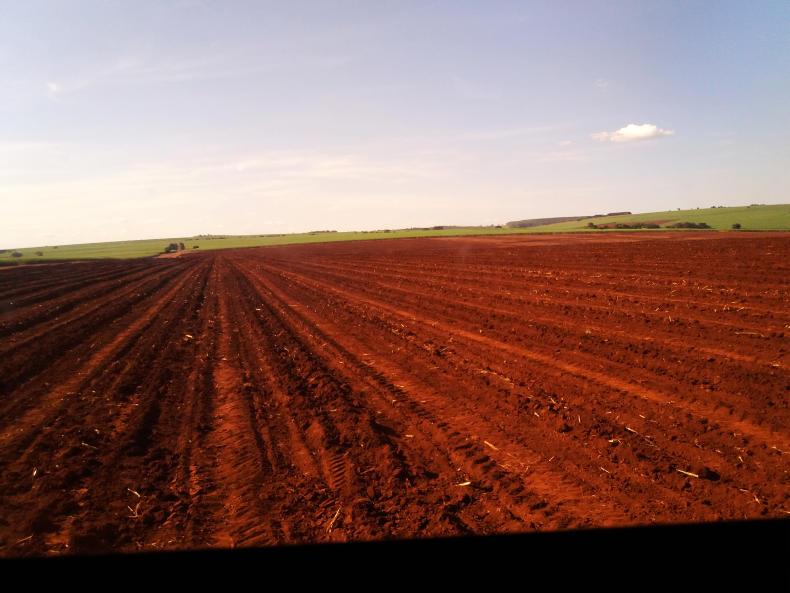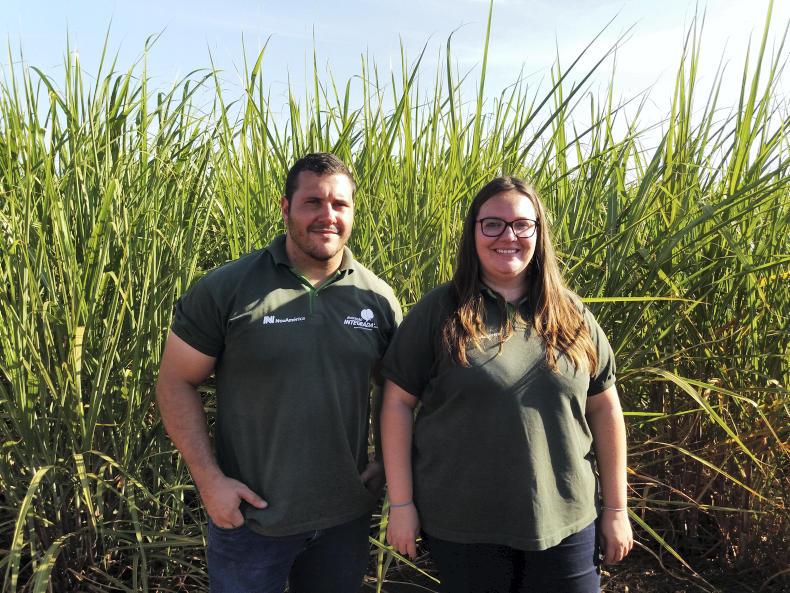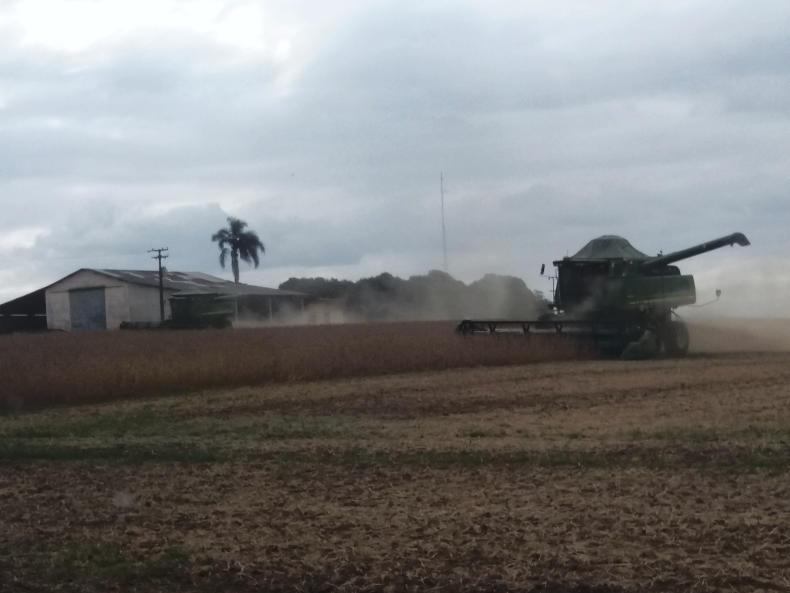NovAmérica manages 98,000ha of land across two Brazilian states in the south of the country – Parana and Mato Grossa do Sul – and employs 2,600 people.
Sugar cane is the company's main crop, but last year it planted a soya bean crop for the first time.
It has a 1,300-strong fleet, made up of 68 harvesters, 317 tractors, 255 trucks and 661 wagons for attaching to trucks.
Fernando Chiarinelli, an agricultural engineer with NovAmérica, said that the two biggest costs for the company are employees (33% of costs) and diesel (30% of costs). A litre of diesel costs Brazilian Reais (BRL) 3/l at the moment, or 69c/l in euro equivalent.
Production cycle
Sugar cane planting takes place between December and April, along with weed, pest and disease control.
Crushing takes places from April to November. NovAmérica harvests an average of 11t of sugar per hectare.

Land which was planted with sugar cane two weeks ago in Brazil.
The crop is sprayed with a fungicide at planting and fertiliser is also spread at the same time.
The company aims to achieve zero mineral fertiliser spreading in the coming years and already uses byproducts from sugar cane production as fertiliser.
At the moment, potassium enriched with phosphorus and urea is spread along with ashes left over from sugar cane processing. A mixture of all compounds is spread at a rate of 400kg/ha.
It makes it own compounds and Chiarinelli said that they are getting better yields as result of using more byproduct and less mineral fertiliser.
"It's less aggressive for the environment and we have more organic matter in the soil, which helps to hold in more water," he said.
Soya beans
NovAmérica has started to diversify within the company and outside of sugar cane is now starting to plant maize and GM soya beans.
"Soya beans are a good business for the company. We need to get out of the box and use land for other crops.
"So far, the soya beans have been good. We are still learning, we weren't soya bean planters. It's a learning process," he said.

Fernando Chiarinelli and Máyra Martins Teixeira of NovAmérica, Brazil.
For the first time, NovAmérica planted 2,700ha of soya beans last year and will be doubling the area next year, he said.
The soya bean is planted in between two rows of sugar cane to "make better use of the land".
The average yield of the soya bean harvested this year was 3.6t/ha. "When you plant more, you earn more," he said.
He said that the biggest issue they had with soya beans was pests, with bugs like Euschistus heros and caterpillars causing some problems but that the problems arose at the end of the plant cycle, so they should not influence soya bean productivity much.
Demand from China
Before NovAmérica planted its 2,700ha of soya beans last year, 70% of the crop was forward-sold and at a profit, Chiarinelli explained.
The yield of 3.6t/ha was the equivalent of 35 60kg bags/ha. The breakeven price per 60kg bag is BRL75/bag or €17.20/bag. NovAmérica forward-sold each bag at BRL79/bag or €18.11/bag.
Challenges
NovAmérica is not without its challenges. Chiarinelli said: "The machines we have for planting and harvesting [sugar cane] are not as well developed [as harvesting equipment for other crops]. There is better results from manual labour, a man with a macheté is better than a machine."
He also said that more and more people working in manual labour are going away from it. "It doesn't matter how much you pay people, people are going away from manual labour."
Read more
Crop Protection: changes set to accelerate
Tillage management: planting, PGR and fungicide priorities
Top Brazilian dairy farmers rearing to expand
NovAmérica manages 98,000ha of land across two Brazilian states in the south of the country – Parana and Mato Grossa do Sul – and employs 2,600 people.
Sugar cane is the company's main crop, but last year it planted a soya bean crop for the first time.
It has a 1,300-strong fleet, made up of 68 harvesters, 317 tractors, 255 trucks and 661 wagons for attaching to trucks.
Fernando Chiarinelli, an agricultural engineer with NovAmérica, said that the two biggest costs for the company are employees (33% of costs) and diesel (30% of costs). A litre of diesel costs Brazilian Reais (BRL) 3/l at the moment, or 69c/l in euro equivalent.
Production cycle
Sugar cane planting takes place between December and April, along with weed, pest and disease control.
Crushing takes places from April to November. NovAmérica harvests an average of 11t of sugar per hectare.

Land which was planted with sugar cane two weeks ago in Brazil.
The crop is sprayed with a fungicide at planting and fertiliser is also spread at the same time.
The company aims to achieve zero mineral fertiliser spreading in the coming years and already uses byproducts from sugar cane production as fertiliser.
At the moment, potassium enriched with phosphorus and urea is spread along with ashes left over from sugar cane processing. A mixture of all compounds is spread at a rate of 400kg/ha.
It makes it own compounds and Chiarinelli said that they are getting better yields as result of using more byproduct and less mineral fertiliser.
"It's less aggressive for the environment and we have more organic matter in the soil, which helps to hold in more water," he said.
Soya beans
NovAmérica has started to diversify within the company and outside of sugar cane is now starting to plant maize and GM soya beans.
"Soya beans are a good business for the company. We need to get out of the box and use land for other crops.
"So far, the soya beans have been good. We are still learning, we weren't soya bean planters. It's a learning process," he said.

Fernando Chiarinelli and Máyra Martins Teixeira of NovAmérica, Brazil.
For the first time, NovAmérica planted 2,700ha of soya beans last year and will be doubling the area next year, he said.
The soya bean is planted in between two rows of sugar cane to "make better use of the land".
The average yield of the soya bean harvested this year was 3.6t/ha. "When you plant more, you earn more," he said.
He said that the biggest issue they had with soya beans was pests, with bugs like Euschistus heros and caterpillars causing some problems but that the problems arose at the end of the plant cycle, so they should not influence soya bean productivity much.
Demand from China
Before NovAmérica planted its 2,700ha of soya beans last year, 70% of the crop was forward-sold and at a profit, Chiarinelli explained.
The yield of 3.6t/ha was the equivalent of 35 60kg bags/ha. The breakeven price per 60kg bag is BRL75/bag or €17.20/bag. NovAmérica forward-sold each bag at BRL79/bag or €18.11/bag.
Challenges
NovAmérica is not without its challenges. Chiarinelli said: "The machines we have for planting and harvesting [sugar cane] are not as well developed [as harvesting equipment for other crops]. There is better results from manual labour, a man with a macheté is better than a machine."
He also said that more and more people working in manual labour are going away from it. "It doesn't matter how much you pay people, people are going away from manual labour."
Read more
Crop Protection: changes set to accelerate
Tillage management: planting, PGR and fungicide priorities
Top Brazilian dairy farmers rearing to expand








 This is a subscriber-only article
This is a subscriber-only article










SHARING OPTIONS: